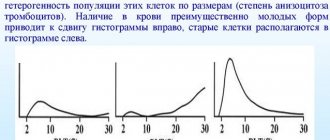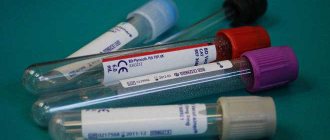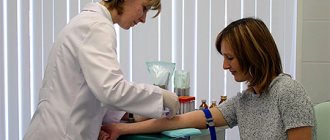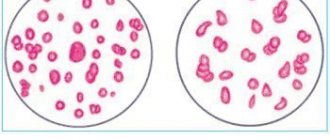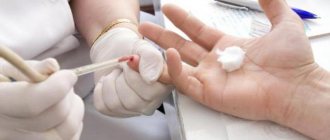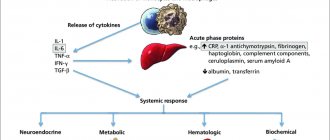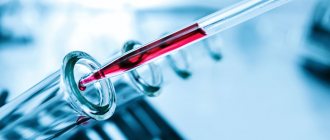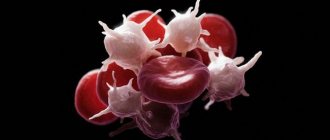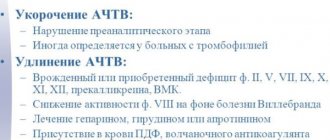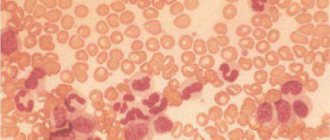The concept of APTT
The APTT indicator characterizes the internal coagulation pathway
Activated partial thromboplastin time is one of the primary indicative tests to characterize the patient's blood clotting ability.
APTT characterizes the activity of the “internal” pathway of the hemostasis system, that is, it indicates the presence or absence of pathological changes in the composition of the blood plasma. APTT depends on the amount and functionality of plasma blood coagulation factors: VIII, IX, XI, XII. The essence of the “internal” mechanism of hemostasis consists in a cascade of activation reactions of the chain of listed factors, which ultimately leads to the activation of prothrombin together with the “external” pathway of hemostasis. The cooperative work of both mechanisms leads to the formation of fibrin, a protein that can stop bleeding.
It is worth remembering that APTT does not depend on the number and functional state of platelets and “tissue” components of hemostasis (thromboplastin and others).
Indications for additional aPTT analysis during pregnancy
Such a study will be carried out more than three times during pregnancy in the following cases:
- conception after numerous unsuccessful attempts to become pregnant;
- several miscarriages in the past;
- complications during previous pregnancies and childbirth (placental abruption, large blood loss at the time of birth);
- intrauterine growth retardation due to fetoplacental insufficiency during a previous pregnancy;
- the presence of two or more fetuses in the uterus;
- pregnancy through IVF;
- history of liver disease in the pregnant woman;
- varicose veins in the expectant mother;
- occasional nosebleeds, increased vulnerability and bleeding gums, a tendency to develop hematomas even after minor bruises;
- previously diagnosed blood diseases;
- hormonal imbalances;
- pathologies of the cardiovascular system;
- sluggish diseases of the genitourinary system;
- autoimmune diseases;
- late toxicosis.
Reduced blood clotting value
Decreased aPTT - risk of thrombosis
Normal aPTT usually varies between 25-35 seconds. Sometimes the upper limit of the norm is indicated as 40-50 seconds, but the value of the lower limit is, as a rule, not disputed by various authors. An APTT reading below this limit (25 seconds) indicates an acceleration of blood clotting (hypercoagulation), which is clinically manifested by a high rate of blood clot formation and, accordingly, with a high probability of the appearance of thrombosis and embolism of blood vessels in various organs.
How to prepare for the APTT test
Blood samples from a vein are taken on an empty stomach. You need to understand that eating any food 5-6 hours before the test can affect the quantitative composition of cells in the body, so to get a clear result you need to take tests on an empty stomach. Drinking water in moderation is not prohibited.
Reasons for decreased aPTT
Taking hormonal drugs affects APTT levels
- Pregnancy. In this case, an APTT of 17-20 seconds is the physiological norm, however, at lower values, pathologies of hemostasis or other reasons should be considered. Hypercoagulation during pregnancy can cause thrombosis of placental vessels, ischemia, hypoxia and fetal death.
- An infectious process caused by bacteria or viruses. However, banal acute respiratory viral infections, as a rule, do not cause severe changes in the blood coagulation system; one should look for a more extensive inflammatory process in the patient’s body.
- Oncological pathology can influence APTT values, however, to select this reason as a justification for reducing APTT, one must have strong grounds with instrumental, laboratory, and clinical evidence of the presence of a tumor.
- Long-term use of oral contraceptives.
- Overdose of vitamin K preparations.
- Thrombosis and thromboembolism:
- pulmonary embolism with vivid symptoms of acute hypoxia and frequent cases of patient death;
- acute thrombosis of the vessels of the extremities with severe tissue ischemia, both with the possibility of vessel recanalization and with a severe outcome - amputation of the limb;
- thromboembolism of cerebral vessels with clinical signs of stroke;
- the first stage of DIC syndrome (occurs with severe and extensive injuries, operations, shock, sepsis, malignant tumors, etc.).
- Incorrect blood collection.
Normal aPTT during pregnancy
After a woman becomes pregnant, the aPTT begins to gradually decrease. If the time of thrombus formation is higher or lower than normal, it is possible that the expectant mother’s history will include information about large blood loss due to bleeding or thromboembolism.
A physiological decrease in aPTT during pregnancy occurs for two reasons:
- In addition to her own blood circulation, a woman has another one - the uteroplacental one. The baby's place is penetrated by an extensive network of blood vessels, so that even if it is slightly damaged, the pregnant woman risks losing a lot of blood. Bleeding, for example, can be caused by placental abruption with high uterine tone;
- the time of thrombus formation is reduced for a compensatory purpose. So, after the baby is born, with the final detachment of the placenta, the woman in labor immediately loses about 400 ml of blood. This is a fairly large volume, so the body’s coagulation system undergoes a real test of strength at this moment: it is necessary to quickly clog the damaged vessels by thrombosis in order to prevent further blood loss. Ideally, the activated time indicators should be reduced to 20 seconds.
The APTT rate for an expectant mother ranges from 23 to 35 seconds.
If you track APTT readings during pregnancy week by week, it becomes clear that they are approximately the same throughout all 9 months:
Treatment
Vitamin K antagonists are the drugs of choice
The volume of therapy depends on the severity of the patient’s condition and the specific nosology; it is determined by the doctor individually.
The main group of drugs for treatment are anticoagulants. The classification of these drugs is extensive. To begin with, two groups of drugs should be distinguished: indirect and direct anticoagulants.
Drugs of the first group are antagonists of vitamin K, which is necessary for the synthesis of certain coagulation factors in the liver. Blocking the formation of these factors leads to a decrease in the activity of the “internal” pathway of hemostasis and normal blood coagulation. Within this group there are coumarin derivatives (syncumar, neodicoumarin, warfarin, dicumarol) and indandione derivatives (phenylin). The most commonly used medicine in this group is warfarin.
Its action against vascular blood clots is extremely effective, but it is difficult to control. An overdose threatens the development of difficult-to-control bleeding, especially in the presence of vulnerabilities in the body: aggravated gastric ulcers, esophageal varices, arterial aneurysms. It is worth remembering that with long-term (sometimes lifelong) use of warfarin, it is necessary to periodically measure the INR, keep it at a favorable level of 2.0-3.0 U, and to do this, adjust the dose of the drug under the supervision of the attending physician.
Direct anticoagulants - drugs for APTT correction
Drugs of the second group, direct anticoagulants: unfractionated heparin, low molecular weight heparins (enoxaparin, nadroparin, dalteparin), heparinoids (sulodexide), rivaroxaban, apixaban, dabigatran. These drugs inhibit the formation and activity of individual coagulation factors; the points of action for each drug are different. The listed medications are a reliable alternative to warfarin, their effect is easier to control, and hemorrhagic complications are observed less frequently. Heparins can be used to treat pregnant women.
Rivaroxaban and dabigatran are the most modern drugs that require virtually no monitoring in the form of blood clotting tests and with the lowest risk of complications.
Additional drugs in the case of thrombosis and embolism are antiplatelet agents that stimulate a decrease in the “sticking” of platelets to each other and to the vascular wall. Drugs in this group include: clopidogrel, aspirin, chimes, eptifibatide and others.
APTT is increased during pregnancy
Thromboplastin time indicators are overestimated if the results of the analysis recorded a blood clotting time of more than 40 s. This means that its ability to form blood clots is very low and there is a risk of bleeding.
Note that the APTT rate during pregnancy always increases under the influence of antibacterial and thrombolytic drugs, as well as aspirin and heparin. If the expectant mother took such medications shortly before the test, you need to inform your doctor about this, otherwise the results will be interpreted incorrectly.
The time required for platelets to “awaken” increases in the following diseases:
- liver diseases complicated by liver failure. In this case, the production of blood clotting factors is disrupted;
- hemophilia A, B and C is a disease that is inherited. It is characterized by a congenital deficiency of coagulation factors and is characterized by spontaneous bleeding;
- the body's urgent need for vitamin K. It appears due to a deficiency of this substance due to dysbacteriosis or an ill-conceived diet;
- leukemia;
- von Willebrand's disease is inherited. It consists in the absence of protein synthesis responsible for the transport of coagulation factors;
- DIC syndrome.
Prevention
It is recommended to avoid foods rich in vitamin K.
With increased blood clotting, the patient can independently decide on a diet. It is recommended to eliminate or reduce the consumption of certain foods rich in vitamin K. These foods include: tomatoes (and other red vegetables and fruits), legumes (peas, soy), some types of meat (beef and veal) and fish (cod), parsley , dill, spinach (the maximum amount of vitamin K among all types of food).
In the absence of obvious thrombotic pathology, but with a decrease in aPTT, women should change some habits: for example, find a replacement for contraception, replace outdated COCs with more modern analogues, or use barrier methods of contraception.
APTT in the blood: what is it, reasons for low and high, norms in coagulogram
© Author: Z. Nelly Vladimirovna, laboratory diagnostics doctor at the Research Institute of Transfusiology and Medical Biotechnology, especially for SosudInfo.ru (about the authors)
APTT (activated partial thromboplastin time) is one of the basic indicators of a coagulogram, assessing the effectiveness of the internal pathway of blood coagulation. Discovered in the middle of the last century (1953), a convenient and easy-to-perform analysis quickly took its rightful place among other laboratory studies, which it firmly holds to this day. This popularity of the indicator is explained by the ability of APTT to act as an independent indicative test used in screening analyzes of the hemostatic system.
Activated partial thromboplastin time, when studying the functioning of the hemocoagulation system, is often “paired” with another important laboratory test - PTT (prothrombin time), which examines the external pathway of activation.
In reference books on clinical laboratory diagnostics, APTT can be found under other names: APTT (activated partial thromboplastin time) and cephalin-kaolin time. However, this does not change the essence of the analysis.
Forecast for life
Diagnosis and treatment determine the patient's prognosis
The prognosis depends solely on the clinical manifestations of the pathology, in which a decrease in aPTT is observed. As is known, in the case of severe diseases (disseminated intravascular coagulation, pulmonary embolism, stroke), it is unfavorable, the patient may become disabled, and sometimes die.
With timely correction of blood clotting, thrombosis can be avoided or quickly neutralized before the appearance of pronounced clinical symptoms or ischemic complications.
Reasons for the decline
When the level drops, the blood becomes thick. It is highly likely that the body produces a lot of specific proteins.
Why is this happening:
- DIC syndrome at the first stage. A condition in which liquid connective tissue begins to randomly coagulate directly in the vessels. The pathology is hereditary or secondary, caused by hormonal disorders. There are exceptions.
Hypercoagulation, and therefore low aPTT, is typical only at the very beginning of the disease. Then the disorder turns 180 degrees, everything becomes the other way around.
- Thrombosis.
- Thromboembolism. In both cases, the drop in the indicator is the result of a secondary pathological process. And sometimes there is no connection at all.
There are also natural factors. Although some of them can be called that very conditionally.
- Exercise stress. Why this happens has already been said earlier. Intense release of hormones, loss of water. The amount of functional blood volume decreases, and cortisol and other steroids accelerate the synthesis of coagulation factors. The result is hypercoagulation. But this is a temporary phenomenon. A healthy body solves the problem itself and quickly brings the system back to normal.
- Errors in nutrition. Substances such as caffeine and tannin have a negative effect on the condition of the blood and blood vessels. They are found in popular drinks. However, as in the previous case, this is not dangerous. At least for healthy people.
- Stressful situations. They provoke an active release of cortisol and adrenaline. It is impossible to completely get rid of nervous tension, because the body. Sometimes symptoms persist for years. It all depends on adaptive abilities.
- Smoking. Patients with considerable experience are especially at risk. The body adapts to the negative factor, but it only seems so. In fact, a person simply stops noticing problems.
- Alcohol is no less aggressive. Ethanol causes hypercoagulation and thickens the blood. The process is complex. When the patient drinks regularly, the disorder becomes persistent. Doesn't go away on its own.
If the aPTT is low, this means that the blood is too thick and this situation is ideal ground for thrombosis. Without treatment, everything can end in disaster.
Factors that may distort the result
Correct blood sampling - eliminating laboratory errors
An important factor to remember when analyzing the results is the correctness of blood collection to study the coagulation properties of plasma.
Errors:
- improper preparation of the patient (taking blood while taking drugs that change its coagulation function, or when the patient is under severe physical or emotional stress);
- technical errors during manipulation (lack of sodium citrate in the test tube, increase in tissue thromboplastin in the blood sample with severe damage to the vessel wall in case of inept or aggressive manipulation, or in the case of an inflammatory process in the injection area).
Preparing the body for analysis
The APTT test can be distorted by the influence of third-party factors: taking medications with specific (anticoagulants) and nonspecific (some antibiotics and antiepileptic drugs) effects, ingestion of thromboplastin due to severe injury to a vein, etc.
To eliminate the possibility of error, you should strictly adhere to the recommendations when preparing for the blood collection procedure:
- stop taking medications 1-2 weeks in advance (the recommendation of the attending physician is required, especially if stopping the drug is impossible);
- 1 week before the procedure, adjust your diet (give up alcohol, coffee, exotic and uncharacteristic dishes for your lifestyle);
- the day before taking blood, limit physical activity;
- on the day of the test, try not to smoke;
- Half an hour before the procedure, you can drink a glass of water.
